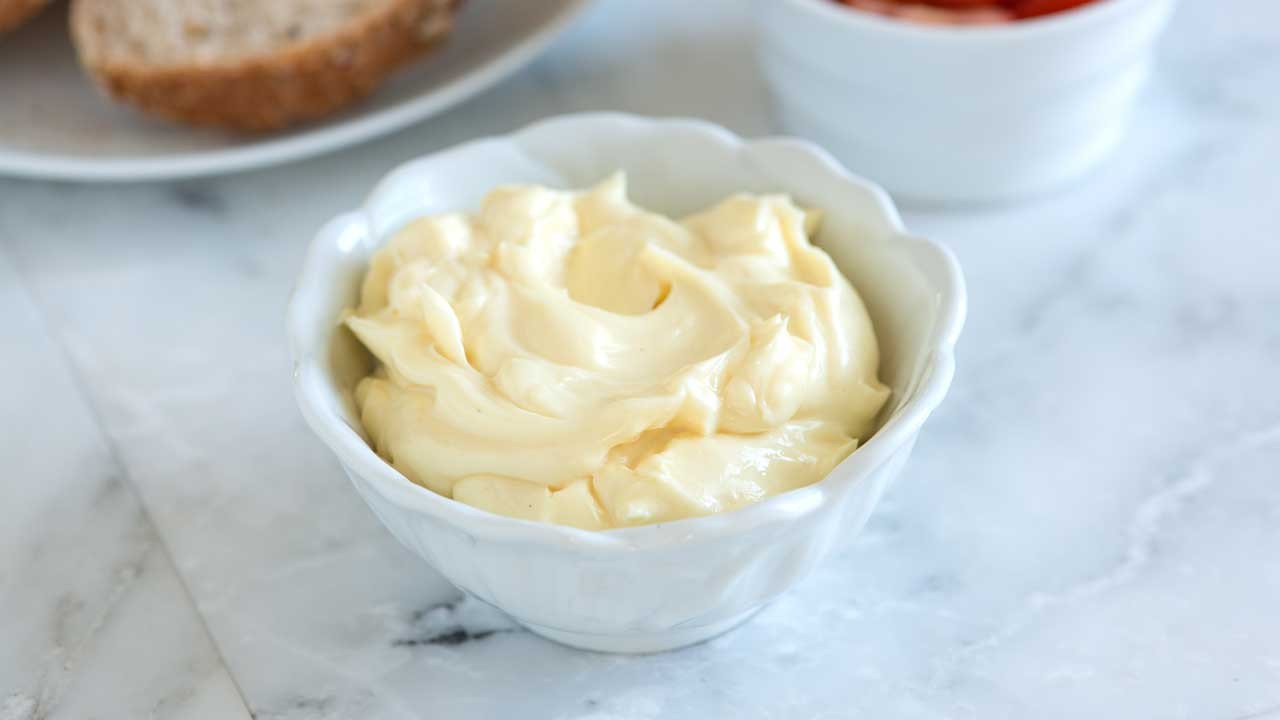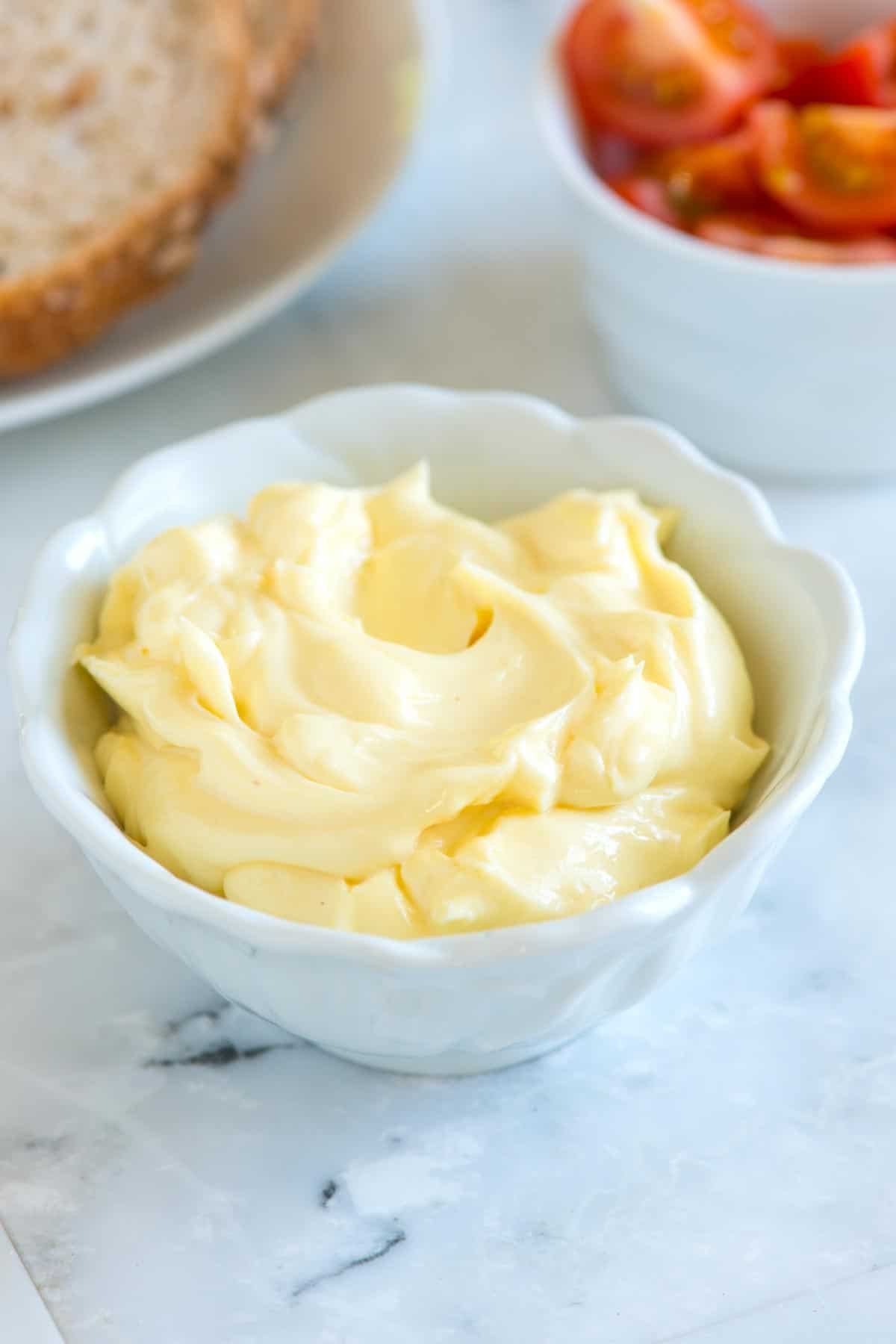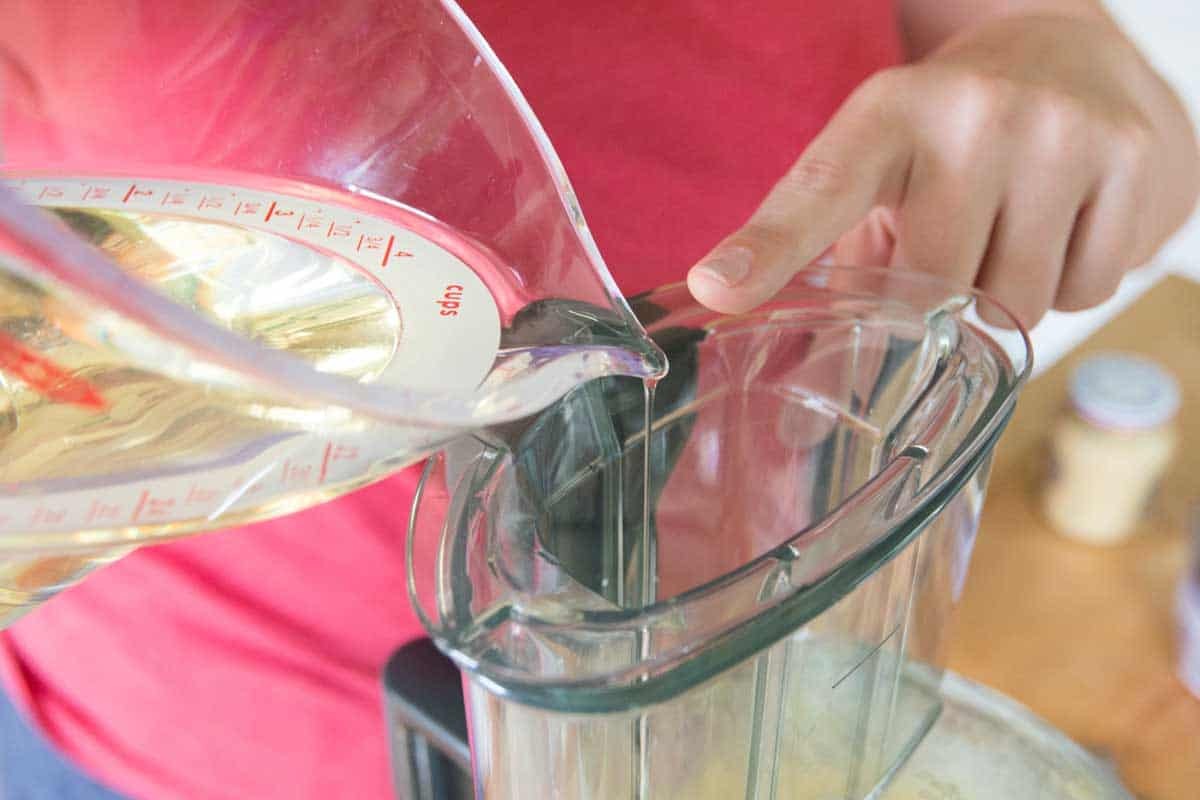What Is Mayonnaise Made Out Of? Mayonnaise, a creamy condiment loved worldwide, features a simple yet fascinating blend of ingredients. At WHAT.EDU.VN, we unravel the mysteries behind your favorite foods and offer free answers to all your burning questions. Discover the essential components of this versatile sauce, exploring its flavor profile, textures, and culinary applications, along with related condiments, mayonnaise alternatives, and nutritional facts.
1. Understanding Mayonnaise: The Basics
Mayonnaise, often simply called mayo, is a cold, emulsified sauce widely used as a condiment. Its rich and tangy flavor makes it a staple in sandwiches, salads, and dips across cultures. But what exactly goes into this creamy concoction?
1.1. The Core Components of Mayonnaise
Traditional mayonnaise is crafted from a handful of essential ingredients:
- Egg Yolks: These provide the emulsifying power, binding the oil and water-based ingredients together to create a stable, creamy texture.
- Oil: A neutral-flavored oil like vegetable, canola, or safflower oil forms the bulk of mayonnaise, lending it richness and body.
- Acid: Vinegar or lemon juice introduces a tangy flavor and helps to preserve the mayonnaise, inhibiting bacterial growth.
- Seasoning: Salt and other spices like mustard add depth and complexity to the overall flavor profile.
1.2. The Emulsification Process
The magic of mayonnaise lies in the emulsification process. Emulsification is the process of combining two liquids that usually don’t mix, such as oil and water. In mayonnaise, egg yolks act as the emulsifier, creating a stable suspension of oil droplets in a water-based solution. This process requires a slow and steady addition of oil while vigorously whisking or blending the ingredients to prevent separation.
2. A Deep Dive Into Mayonnaise Ingredients
Let’s explore each ingredient in detail, understanding its role and potential variations.
2.1. The Role of Eggs in Mayonnaise
Egg yolks are the heart of traditional mayonnaise, providing lecithin, a natural emulsifier. Lecithin molecules have a water-loving (hydrophilic) end and an oil-loving (hydrophobic) end, allowing them to bridge the gap between oil and water.
2.1.1. Whole Eggs vs. Egg Yolks
Some recipes use whole eggs for a slightly different texture and flavor. While whole eggs still contain lecithin, the higher water content may require adjustments to the oil quantity. Using whole eggs can make the process easier and more forgiving, reducing the risk of the emulsion breaking.
2.1.2. Pasteurized Eggs
For safety, especially for those concerned about consuming raw eggs, pasteurized eggs are a great option. These eggs have been heated to a temperature that kills bacteria like Salmonella without cooking the egg.
2.2. Selecting the Right Oil
The type of oil significantly impacts the flavor and texture of mayonnaise.
2.2.1. Neutral Oils
Vegetable oil, canola oil, safflower oil, and sunflower oil are popular choices for their mild flavor, allowing the other ingredients to shine. These oils also tend to create a lighter-colored mayonnaise.
2.2.2. Olive Oil
While olive oil can be used, it imparts a distinct flavor that may not appeal to everyone. Extra virgin olive oil, in particular, can be too strong. If using olive oil, opt for a light or refined variety.
2.2.3. Avocado Oil
Avocado oil is another healthy option, offering a subtle, buttery flavor. However, it can be more expensive than other oils and may produce a slightly thicker mayonnaise.
2.3. The Acidity Factor: Vinegar and Lemon Juice
Acid not only adds a tangy flavor but also acts as a preservative and helps stabilize the emulsion.
2.3.1. Vinegar Varieties
White vinegar, apple cider vinegar, and white wine vinegar are common choices. Each offers a slightly different flavor profile, with white vinegar being the most neutral.
2.3.2. Lemon Juice
Freshly squeezed lemon juice provides a bright, citrusy flavor and is a popular alternative to vinegar. It also contains natural antioxidants that can help extend the shelf life of the mayonnaise.
2.4. Seasoning and Flavor Enhancements
Salt is essential for balancing the flavors, while other seasonings can add complexity and personality.
2.4.1. Mustard
Mustard, especially Dijon mustard, is a common addition, contributing flavor and acting as a secondary emulsifier. The lecithin in mustard seeds helps to further stabilize the emulsion.
2.4.2. Spices and Herbs
Garlic powder, onion powder, paprika, cayenne pepper, and dried herbs can be added to create flavored mayonnaise variations. Fresh herbs like dill, parsley, and chives can also be incorporated for a burst of flavor.
3. Crafting Homemade Mayonnaise: A Step-by-Step Guide
Making mayonnaise at home is surprisingly easy and rewarding. Here’s a basic recipe:
3.1. Basic Homemade Mayonnaise Recipe
Ingredients:
- 1 large egg yolk (or 1 whole egg for a milder flavor)
- 1 tablespoon Dijon mustard
- 1 tablespoon vinegar or lemon juice
- 1/4 teaspoon salt
- 1 cup neutral-flavored oil (vegetable, canola, or safflower)
Instructions:
- Combine: In a bowl or food processor, whisk together the egg yolk (or whole egg), mustard, vinegar or lemon juice, and salt.
- Emulsify: Slowly drizzle in the oil, drop by drop, while continuously whisking or processing. This is crucial for creating a stable emulsion.
- Thicken: As the mixture thickens, you can gradually increase the stream of oil.
- Adjust: Once all the oil is incorporated, taste and adjust seasoning as needed. Add more salt, vinegar, or lemon juice to taste.
- Store: Transfer to an airtight container and refrigerate for up to two weeks.
3.2. Tools and Techniques
3.2.1. Whisking by Hand
This method requires patience and arm strength but provides the most control over the emulsification process.
3.2.2. Food Processor
A food processor makes the process faster and easier. Use the pulse function to slowly incorporate the oil.
3.2.3. Immersion Blender
An immersion blender is another convenient option. Place all ingredients in a jar and blend from the bottom up, slowly lifting the blender as the mayonnaise emulsifies.
3.3. Troubleshooting Common Issues
3.3.1. Broken Mayonnaise
If the mayonnaise separates, it means the emulsion has broken. To fix it, start with a fresh egg yolk in a clean bowl. Slowly drizzle in the broken mayonnaise, whisking constantly, until the emulsion is re-established.
3.3.2. Thin Mayonnaise
If the mayonnaise is too thin, slowly drizzle in more oil while whisking or processing until it reaches the desired consistency.
3.3.3. Thick Mayonnaise
If the mayonnaise is too thick, add a teaspoon of water or lemon juice while whisking or processing until it thins out.
4. Mayonnaise Variations: Exploring Flavored Options
The possibilities are endless when it comes to flavoring mayonnaise. Here are a few ideas:
4.1. Garlic Aioli
Add minced garlic or roasted garlic cloves for a pungent, savory flavor.
4.2. Chipotle Mayonnaise
Stir in chipotle peppers in adobo sauce for a smoky, spicy kick.
4.3. Sriracha Mayonnaise
Mix in Sriracha sauce for a fiery, tangy flavor.
4.4. Herb Mayonnaise
Add chopped fresh herbs like dill, parsley, chives, or tarragon for a fresh, aromatic flavor.
4.5. Lemon-Dill Mayonnaise
Combine lemon zest, lemon juice, and fresh dill for a bright, herbaceous flavor.
5. Mayonnaise in Culinary Applications
Mayonnaise is a versatile condiment with countless uses in the kitchen.
5.1. Sandwiches and Wraps
Mayonnaise adds moisture and flavor to sandwiches and wraps. It can be used as a base for spreads or mixed with other ingredients like herbs, spices, or sauces.
5.2. Salads
Mayonnaise is a key ingredient in many salads, including potato salad, coleslaw, macaroni salad, and chicken salad. It binds the ingredients together and adds a creamy texture.
5.3. Dips and Sauces
Mayonnaise can be used as a base for dips and sauces, such as tartar sauce, ranch dressing, and aioli. It adds richness and body to the final product.
5.4. Dressings
Mayonnaise can be thinned with vinegar, lemon juice, or other liquids to create creamy salad dressings.
5.5. Baking
In some baking recipes, mayonnaise can be used as a substitute for eggs or oil, adding moisture and richness to cakes, muffins, and other baked goods.
6. Mayonnaise Alternatives: Exploring Egg-Free Options
For those with egg allergies or dietary restrictions, several egg-free mayonnaise alternatives are available.
6.1. Vegan Mayonnaise
Vegan mayonnaise is typically made with aquafaba (the liquid from cooked chickpeas), soy milk, or other plant-based ingredients. These ingredients act as emulsifiers, creating a creamy texture similar to traditional mayonnaise.
6.2. Yogurt-Based Mayonnaise
Greek yogurt can be used as a base for a healthier mayonnaise alternative. It provides a tangy flavor and creamy texture while being lower in fat and calories.
6.3. Avocado Mayonnaise
Avocado can be blended with lemon juice, vinegar, and seasonings to create a creamy, healthy mayonnaise alternative.
7. Nutritional Information and Health Considerations
Mayonnaise is a high-fat condiment, so it’s important to consume it in moderation.
7.1. Calorie and Fat Content
One tablespoon of regular mayonnaise contains approximately 90-100 calories and 10-11 grams of fat.
7.2. Health Benefits
While mayonnaise is high in fat, it also contains vitamin E, an antioxidant that protects cells from damage. Additionally, some mayonnaise alternatives, like those made with avocado or yogurt, offer additional health benefits.
7.3. Potential Concerns
Mayonnaise is often high in sodium and may contain unhealthy additives. It’s important to read labels carefully and choose brands with minimal ingredients and lower sodium content.
8. Common Questions About Mayonnaise (FAQ)
| Question | Answer |
|---|---|
| What is the main ingredient in mayonnaise? | The main ingredients in mayonnaise are egg yolks, oil, and an acid such as vinegar or lemon juice. |
| Is mayonnaise vegan? | Traditional mayonnaise is not vegan as it contains egg yolks. However, vegan mayonnaise alternatives are available, made with plant-based ingredients like aquafaba or soy milk. |
| How long does homemade mayonnaise last? | Homemade mayonnaise typically lasts up to two weeks in the refrigerator, when stored in an airtight container. |
| Can I use olive oil to make mayonnaise? | Yes, but it’s best to use a light or refined olive oil to avoid an overpowering flavor. Extra virgin olive oil can be too strong. |
| What can I use instead of eggs in mayonnaise? | Vegan mayonnaise recipes often use aquafaba (the liquid from cooked chickpeas), soy milk, or other plant-based ingredients as emulsifiers. |
| How do I fix broken mayonnaise? | Start with a fresh egg yolk in a clean bowl. Slowly drizzle in the broken mayonnaise, whisking constantly, until the emulsion is re-established. |
| Is mayonnaise healthy? | Mayonnaise is high in fat and calories, so it should be consumed in moderation. However, it also contains vitamin E and can be part of a balanced diet. Healthier alternatives, like those made with avocado or yogurt, are also available. |
| What is the difference between mayonnaise and aioli? | Aioli is traditionally made with garlic, olive oil, and an emulsifier such as egg yolks. Mayonnaise is a broader term and can be made with various oils and flavorings. |
| Can I freeze mayonnaise? | Freezing mayonnaise is not recommended as it can cause the emulsion to break and the texture to become unappealing. |
| What are some flavor variations of mayonnaise? | You can add minced garlic (aioli), chipotle peppers (chipotle mayonnaise), Sriracha sauce (Sriracha mayonnaise), or fresh herbs (herb mayonnaise) to create flavored mayonnaise variations. |



9. Conclusion: The Versatile World of Mayonnaise
Mayonnaise is more than just a condiment; it’s a culinary building block with endless possibilities. Whether you prefer classic homemade mayo or a creative flavored variation, understanding the ingredients and techniques involved allows you to create delicious and satisfying dishes. Remember to enjoy it in moderation as part of a balanced diet.
10. Need More Answers? Ask WHAT.EDU.VN!
Still curious about mayonnaise or other culinary topics? Don’t hesitate to ask your questions on WHAT.EDU.VN! Our community of experts is ready to provide free and accurate answers to all your queries.
Are you struggling to find quick, free answers to your burning questions? Tired of endless searches and unreliable information? At WHAT.EDU.VN, we understand your challenges. We provide a platform where you can ask any question and receive fast, accurate answers from knowledgeable individuals.
Don’t let your curiosity be stifled! Visit WHAT.EDU.VN today and experience the ease and convenience of getting your questions answered for free. Our dedicated team is here to help you find the information you need, when you need it.
Contact Us:
Address: 888 Question City Plaza, Seattle, WA 98101, United States
Whatsapp: +1 (206) 555-7890
Website: what.edu.vn